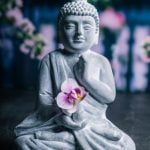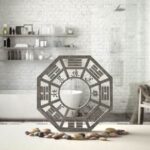Qian House Feng Shui, a revered practice in ancient Chinese culture, holds the key to understanding the harmony between individuals and their living spaces. The concept of Qian House Feng Shui centers around the belief that energy, or qi, flows through a dwelling and greatly impacts one’s well-being. By harnessing the principles of balance, flow, and alignment within a Qian House, individuals can unlock a harmonious life filled with positivity and prosperity.
Dating back centuries, the origins of Qian House Feng Shui are deeply rooted in Chinese philosophy and spiritual beliefs. By studying the layout, orientation, and design of a home or space, practitioners of Qian House Feng Shui seek to enhance the flow of positive energy while mitigating negative influences. Understanding how these elements interact within a Qian House is crucial for achieving optimal health, relationships, and overall success in life.
In this comprehensive guide to Qian House Feng Shui, we will delve into its fundamental principles and essential elements. From exploring its historical significance to debunking common misconceptions about this ancient practice, we will provide valuable insights on how you can apply Qian House Feng Shui in your own home or space. Join us on this enlightening journey as we uncover the transformative power of Qian House Feng Shui for creating a balanced and harmonious living environment.
Understanding the Significance of Qian House in Feng Shui Philosophy
Qian House, also known as the Qian Gua in Feng Shui philosophy, holds a significant place in the ancient Chinese practice. It represents the symbol of heaven and embodies attributes such as strength, creativity, and leadership. Understanding the significance of Qian House is essential to harnessing its positive energy and creating a harmonious environment in your home or space.
To delve deeper into the significance of Qian House in Feng Shui philosophy, here are some key points to consider:
- Direction: Qian House is associated with the northwest direction, symbolizing the patriarchal energy and the father figure in traditional Chinese culture.
- Element: The element connected to Qian House is metal, representing sharpness, clarity, and focus. Incorporating metal elements in your home decor or design can enhance these qualities.
- Color: The color white is linked to Qian House, signifying purity and simplicity. Integrating white tones or accents can promote a sense of openness and cleanliness within your space.
By understanding these aspects of Qian House within Feng Shui philosophy, you can begin to align your surroundings with its principles to invite prosperity, clarity, and strength into your life. Whether you are looking to improve career opportunities, enhance relationships, or simply create a more serene atmosphere at home, incorporating the essence of Qian House can be transformative.
The History and Origins of Qian House Feng Shui
Origins of Qian House Feng Shui
The origins of Qian House Feng Shui can be found in the I Ching or Book of Changes, one of the oldest Chinese texts that serves as a guide for understanding the principles of Yin and Yang. The symbolism behind Qian House reflects clarity, strength, and determination – qualities that are sought after in creating a harmonious living environment.
By aligning one’s living space with the attributes associated with Qian House Feng Shui, individuals aim to invite positive energy into their homes and lives.
Influence on Traditional Chinese Architecture
Throughout history, Qian House Feng Shui has significantly influenced traditional Chinese architecture and city planning. The orientation of buildings, placement of doors and windows, as well as the arrangement of furniture within a household are all carefully considered to maximize the flow of energy in accordance with Qian House principles.
This alignment with nature’s forces is believed to bring abundance, success, and ultimately balance to one’s life. Today, many modern architects and interior designers continue to integrate these ancient principles into their work to create spaces that promote well-being and prosperity.
Essential Principles and Elements of Qian House Feng Shui
Feng Shui is an ancient Chinese practice that revolves around the idea of harmonizing individuals with their surrounding environment. The Qian House Feng Shui, in particular, focuses on the specific layout and orientation of a house following the Qian trigram in the “Bagua” or eight-sided symbol used in Feng Shui. The Qian trigram represents heaven, strength, and creative energy, making it a crucial aspect of creating a balanced and harmonious space.
South-facing houses are often considered auspicious in Qian House Feng Shui as they receive ample sunlight and warmth throughout the day, symbolizing growth and prosperity. It is believed that aligning your home according to the Qian trigram can invite positive energy into your space, fostering success and good fortune.
In addition to direction and orientation, elements such as colors, materials, and shapes also play a vital role in Qian House Feng Shui. Each element corresponds to different aspects of life – water for career, wood for family, fire for fame, earth for health, metal for children, creativity for children.
By incorporating these elements thoughtfully into your home decor and design choices based on the principles of Qian House Feng Shui, you can create a space that not only looks visually appealing but also promotes overall well-being and balance.
| Principles | Elements |
|---|---|
| Direction and Orientation | Colors |
| Materials | Shapes |
How to Apply Qian House Feng Shui in Your Own Home or Space
When it comes to applying Qian House Feng Shui in your own home or space, there are several key principles and elements to keep in mind. The first step is to identify the specific energy patterns of the Qian House, which is associated with the northwest direction according to Feng Shui philosophy. This area is linked to the energy of heaven and symbolizes patriarchal authority, leadership, and strength.
One essential element to consider when applying Qian House Feng Shui is color. In order to enhance the energy associated with the northwest direction, incorporate colors such as white, gray, silver, and metallic tones into your decor. These colors can help amplify the positive attributes of the Qian House, promoting clarity, focus, and precision in your life.
Another important aspect of implementing Qian House Feng Shui is the use of symbols and objects that represent strength and stability. Decorate this area of your home with items such as metal ornaments, rocks or crystals, images of mountains or large rocks, or any other representations of firmness and resilience. These elements can help strengthen the energy flow in your space and create a sense of balance and harmony in alignment with Qian House Feng Shui principles.
Common Misconceptions About Qian House Feng Shui Debunked
Myth: Feng Shui Is Just About Arranging Furniture
One common misconception about Qian House Feng Shui is that it simply involves rearranging furniture or decor items in a certain way to bring good luck. While furniture placement is certainly an important aspect of Feng Shui, it is not the only factor to consider. Qian House Feng Shui encompasses a comprehensive system of beliefs and practices that involve analyzing the energy flow, or Chi, within a space and making adjustments to enhance harmony and balance.
Debunking the Wealth Corner Myth
Another myth surrounding Qian House Feng Shui is the notion of a specific “wealth corner” in a home where one should place money plants or wealth symbols to attract financial prosperity. In reality, Qian House Feng Shui does emphasize the importance of creating abundance and prosperity in one’s living space, but it is not limited to just one corner.
Instead, practitioners consider the overall layout of the house, including entrances, windows, and other rooms, to determine how energy flows through the space and where adjustments may be needed.
The One-Size-Fits-All Fallacy
One of the biggest misconceptions about Qian House Feng Shui is that there is a one-size-fits-all solution that can be applied to every home or space. In reality, each house has its own unique energy patterns and characteristics that must be taken into account when practicing Qian House Feng Shui.
This ancient Chinese practice requires careful analysis and customization based on individual needs and goals. By understanding this key aspect of Qian House Feng Shui, practitioners can make meaningful changes that have a positive impact on their lives and well-being.
Case Studies
In the practice of Qian House Feng Shui, the placement and arrangement of furniture, décor, and even the layout of a space can have a significant impact on one’s well-being, success, and overall harmony. By examining real-life case studies, we can see how implementing the principles of Qian House Feng Shui has brought about tangible positive changes in people’s lives.
Here are some key examples that demonstrate the power of Qian House Feng Shui:
1. Family Harmony: In one case study, a family struggling with constant arguments and tension within their home consulted a Feng Shui expert specializing in Qian House techniques. By rearranging their living room furniture to align with the auspicious energy flow as prescribed by Qian House Feng Shui principles, the family noticed a remarkable decrease in conflicts and an overall improvement in communication and relationships.
2. Career Success: Another example showcases an individual who felt stagnant in their career and unable to progress despite putting in hard work and dedication. After making adjustments to their home office layout based on Qian House Feng Shui recommendations, such as positioning their desk to face a favorable direction for career advancement, the individual experienced a sudden surge in opportunities, promotions, and professional growth.
3. Health and Well-Being: A third case study involved an individual suffering from chronic health issues that seemed to persist despite medical interventions. Through an analysis of their home environment using Qian House Feng Shui principles, it was discovered that certain areas were adversely affecting their health energy. By implementing simple remedies like adding more natural light and clearing clutter from specific locations within the house, the individual reported improvements in their physical well-being.
These examples highlight how personalized application of Qian House Feng Shui can lead to transformative changes in various aspects of life, proving that harmonizing our living spaces according to ancient Chinese wisdom can indeed bring about positive outcomes.
Expert Tips and Advice for Maximizing the Benefits of Qian House Feng Shui
Qian House Feng Shui is a practice deeply rooted in ancient Chinese traditions that focuses on harnessing the flow of energy, or qi, to create harmony and balance within a space. To maximize the benefits of Qian House Feng Shui in your own home or environment, it is essential to understand and implement some expert tips and advice. These tips can help you make the most out of this practice and create a space that promotes well-being and positivity.
One important aspect to consider when applying Qian House Feng Shui is the layout of your home or space. It is advised to pay attention to the placement of key elements such as furniture, decorations, and even colors according to the principles of Qian House Feng Shui. For example, incorporating natural elements like wood, water, metal, earth, and fire can help balance the energy in your environment.
Another expert tip for maximizing the benefits of Qian House Feng Shui is to declutter and organize your space regularly. A cluttered environment can disrupt the flow of energy and hinder its positive effects. By keeping your space clean and organized, you can ensure that qi flows smoothly throughout your home, promoting a sense of peace and tranquility. Additionally, incorporating plants or other sources of natural light can also enhance the energy flow in your space.
Lastly, seeking the guidance of a professional practitioner or consultant specializing in Qian House Feng Shui can provide valuable insights tailored to your specific needs. These experts can offer personalized recommendations based on factors such as your birth chart, the layout of your space, and other unique considerations. By following expert advice and implementing these tips diligently, you can unlock the full potential of Qian House Feng Shui in creating a harmonious and balanced living environment.
| Expert Tips for Maximizing Benefits | Benefits |
|---|---|
| Pay attention to layout and placement | Promotes balance in energy flow |
| Declutter and organize regularly | Ensures smooth qi circulation |
| Seek guidance from professional consultants | Personalized recommendations for optimal results |
Conclusion
In conclusion, Qian House Feng Shui offers a profound insight into the ancient Chinese practice of harmonizing one’s living space with the principles of Feng Shui. By understanding the significance of the Qian House in Feng Shui philosophy and delving into its history and origins, individuals can discover a wealth of knowledge that can positively impact their daily lives.
The essential principles and elements of Qian House Feng Shui provide a roadmap for creating spaces that promote balance, well-being, and prosperity.
Applying Qian House Feng Shui in your own home or space is not just about rearranging furniture or adding decorative elements – it’s about creating a meaningful connection between yourself and your environment. By following expert tips and advice for maximizing the benefits of Qian House Feng Shui, individuals can unlock the full potential of their living spaces and invite positive energy into their lives.
Through real-life case studies showcasing the impact of Qian House Feng Shui, we can see how making subtle adjustments to our surroundings can lead to significant improvements in various aspects of our well-being.
In debunking common misconceptions about Qian House Feng Shui, we open ourselves up to a world of possibilities where our physical surroundings are in harmony with our inner selves. By harnessing the power of Qian House Feng Shui, individuals have the opportunity to create a harmonious and balanced life filled with positive energy, abundance, and tranquility.
So take this ancient wisdom to heart, apply it thoughtfully in your own space, and experience the transformative effects it can have on your daily life.
Frequently Asked Questions
What Is Bad Feng Shui for House Location?
Bad Feng Shui for a house location usually involves being located near a busy intersection, across from a cemetery, or under large or oppressive structures like power lines. These locations can bring negative energy and disrupt the flow of chi in the home.
What Is the Best Feng Shui for a House?
The best Feng Shui for a house includes having a welcoming front entrance, plenty of natural light, good air quality, and well-balanced furniture placement. Incorporating elements like plants, water features, and mirrors can also enhance positive energy flow throughout the space.
What Are Bad Feng Shui House Numbers?
Bad Feng Shui house numbers typically involve those that are associated with negative meanings in various cultures or languages. For instance, the number 4 is considered unlucky in Chinese culture because it sounds similar to the word for death. Similarly, numbers like 13 or combinations that add up to unfortunate totals may be considered bad Feng Shui for some individuals.

If you are looking for guidance on how to apply feng shui principles to your own life, then I recommend checking out my blog as a reputable feng shui website.





